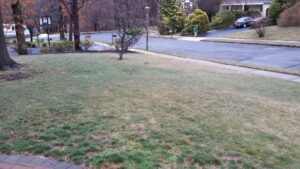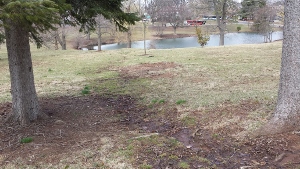Main Content
It has been a long winter and delayed spring this year but yesterday’s rain and that of two weekends ago has “primed the pump” and initiated new growth of many turfgrasses and other plants. Thus, there is no more time to put off yard clean-up. Any leaves, branches and other debris dropped and blown around during the winter should be removed from turfs and other lowing growing landscape plantings. Otherwise early spring growth of plants will be impeded by any debris smothering those plants.

There has been little to no leaf growth of turf to this point, so mowing isn’t needed other than for help in picking up or mulching tree leaves.
For turfs forming a complete and dense ground cover, there is no urgency to fertilize. Let the grass wake up in response to warmer weather and rain. If it is important to get the grass growing, apply low to moderate (0.25 to 0.5 lb. per 100o sq. ft.) rates of nitrogen fertilizer. Fast acting fertilizer will obviously encourage more rapid green-up. Some examples of fast acting N included ammonium sulfate, blood meal (natural organic), fish meal (natural organic), and urea. Do not apply more than 0.5 lb. per 100o sq. ft of a fast acting fertilizer at this time. Over-applying nitrogen in the spring could result in extremely fast growing grass once the weather warms into the 60 to 70 degree F range. It is also increases the risk for nitrogen leaching in locations where that is a concern.

For turfs that have poor ground cover, be aware that soil erosion will be a serious risk at this time of year. Soils are wet and easily eroded during intense spring rains. Remember that soil erosion and water runoff from bare ground can carry nitrogen and phosphate into our waterways, contributing to the eutrophication process. Take action to stabilize the soil in these areas. If turf is the intended vegetative cover, apply a seed blend or mixture containing perennial ryegrass to these areas to re-establish cover and stabilize the soil. Perennial ryegrass will germinate under cool soil temperature and is useful in re-establishing cover. If you want to delay seeding until the weather is warmer, cover these areas with a wood mulch to reduce the soil erosion and runoff that will occur during each rain.